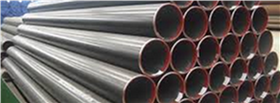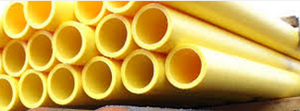Overview
Pipelines within the authority of the Pipeline and Hazardous Materials Safety Administration (PHMSA) are categorized by what they transport – hazardous liquids, gas, and liquefied natural gas. Pipelines can be further described by their place in the process between the production site and the final delivery point of the products transported through the pipelines. These places in the process are typically described as: gathering pipelines, transmission pipelines, and distribution pipelines.
The type of pipe material used in a pipeline depends on the expected service requirements and operating parameters for the pipeline. Most gathering and transmission pipelines are constructed of steel, although a relatively very small portion of gas transmission pipelines are constructed of plastic, iron, composite and other materials. Gas distribution pipelines, which represent the largest amount of pipeline mileage in the U.S., are constructed predominantly of plastic or steel. A much smaller portion of gas distribution pipelines are made of iron, copper, or other materials.
Steel Pipelines
 In operator annual report data submitted to PHMSA as of June 2015, steel pipe is predominately used in hazardous liquid pipelines(1). This includes crude oil gathering and transmission pipelines, as well as transmission pipelines transporting refined petroleum products. Federal regulations in 49 CFR § 195.8 specify that “No person may transport any hazardous liquid or carbon dioxide through a pipe that is constructed after October 1, 1970, for hazardous liquids, or after July 12, 1991, for carbon dioxide of material other than steel unless the person has notified the Administrator in writing at least 90 days before the transportation is to begin.” Steel is also used predominantly in gas gathering and transmission pipelines.
In operator annual report data submitted to PHMSA as of June 2015, steel pipe is predominately used in hazardous liquid pipelines(1). This includes crude oil gathering and transmission pipelines, as well as transmission pipelines transporting refined petroleum products. Federal regulations in 49 CFR § 195.8 specify that “No person may transport any hazardous liquid or carbon dioxide through a pipe that is constructed after October 1, 1970, for hazardous liquids, or after July 12, 1991, for carbon dioxide of material other than steel unless the person has notified the Administrator in writing at least 90 days before the transportation is to begin.” Steel is also used predominantly in gas gathering and transmission pipelines.
Steel pipe used in the design and construction of pipelines can range in size from several inches to several feet in diameter. They can range in length from hundreds of feet to hundreds of miles. Steel pipe is manufactured to design specifications, usually in 20-foot sections that are joined by field welding as the pipeline is being constructed.
Bare Steel Pipe
Gas and hazardous liquids pipelines that are uncoated are known as “bare steel pipelines.” While many bare steel pipelines have been taken out of service and are no longer used, some continue to operate today. The following table shows the approximate mileage of bare steel pipe currently in use.
| System Type | Approximate Total Miles | Approximate Percent of Total Miles (of system type) |
|---|---|---|
| Hazardous Liquid | 3,808 | 1.9 |
| Gas Transmission | 5,660 | 1.9 |
| Gas Distribution – Mains | 54,427 | 3.2 |
| Gas Distribution – Service Lines | 26,141 | 2.9 |
*Source: PHMSA Pipeline Operator Annual Reports Data as of 6/25/2015.
Bare steel pipe was used extensively in gas and hazardous liquids pipelines until the 1960’s, when the use of plastic pipe expanded for natural gas distribution systems and Federal regulations came to fruition. Until pipeline coatings were required with the establishment of Federal mandates in 1971, some natural gas transmission and distribution operators continued to install steel pipelines without coatings, particularly in dry areas of the country.
Plastic Pipelines
A very small portion of gas transmission pipelines are constructed of plastic pipe. However, the largest portion of gas distribution pipelines, both mains and service lines, is constructed of plastic pipe. The next largest is constructed of steel pipe. Gas distribution pipelines are also constructed of iron, copper and other materials.
| Mains | Services | |||
|---|---|---|---|---|
| Pipe Material | Total Miles | Percent of Mains Miles | Total Miles | Percent of Services Miles |
| Plastic | 689,077.4 | 54.50 | 636,292.8 | 70.60 |
| Steel | 544,307.8 | 43.05 | 232,991.0 | 25.85 |
| Iron | 29,982.8 | 2.37 | 152.3 | 0.02 |
| Other Materials | 930.2 | 0.07 | 19,750.7 | 2.19 |
| Copper | 19.9 | 0.00 | 12,088.8 | 1.34 |
**Source: PHMSA Pipeline Operator Annual Reports Data as of 6/12/2015.
 Plastic pipe has been actively used in the natural gas industry since the late 1950s, and ASTM(2) and ASME(3) standards exist for polyethylene (PE) plastic pipe. PHMSA regulations address the use of plastic pipe.
Plastic pipe has been actively used in the natural gas industry since the late 1950s, and ASTM(2) and ASME(3) standards exist for polyethylene (PE) plastic pipe. PHMSA regulations address the use of plastic pipe.
Some operators are currently using plastic pipe as they accelerate the replacement of high-risk distribution pipeline infrastructure. They may currently employ other polymers, such as polyamide-11 (PA-11), more commonly known as a “nylon,” in addition to PE and steel pipe. Another polyamide material (PA-12) has also been used through state waivers/special permits, and is currently being proposed for incorporation in the code through a Plastic Pipe Notice of Proposed Rulemaking.
There has also been interest in the use of a variety of homogeneous plastics and other composite materials for systems such as gathering (both gas and hazardous liquid) for a number of reasons including to help address issues related to corrosion. Plastics and composites are in use in non-regulated facilities currently, but have relatively limited use currently in regulated systems outside of State waivers/special permits.
More information on pipe materials:
- 49 CFR Part 192 – Transportation of Natural and Other Gas by Pipeline: Minimum Federal Safety Standards, Subpart B – Materials, Subpart C – Pipe Design.
- 49 CFR §195.8 – Transportation of hazardous liquid or carbon dioxide in pipelines constructed with other than steel pipe.
- PHMSA Pipeline Replacement Updates
- DOT Call to Action
- Oil Pipeline Characteristics and Risk Factors: Illustrations from the Decade of Construction. Report prepared by John Kiefner (Kiefner & Associates, Inc.) and Cheryl Trench (Allegro Energy Group). December 2001.
- A Rational Approach to Pipeline Material Selection. Krupavaram Nalli (Tebodin & Partners, LLC). Pipeline and Gas Journal. December 2011.
- Selection of Pipe Material for Low-Temperature Service. Ramesh Singh (Gulf Interstate Engineering). Pipeline and Gas Journal. June 2009.
- Analysis Points to Pipe Alloy for Safe and More Economical LNG Transport. Richard Freeman (Corus Tubes), Steve Langford (J P Kenny). Pipeline and Gas Journal. November 2008.
- Advanced Research Under Way On PE Pipe For Natural Gas. Joseph P. Mallia, Angelo Fabiano, and Hitesh Patadia. Pipeline and Gas Journal. October 2010.
- PE 100 Material Makes Manitoba Gas Main Project Economically Viable. Dr. Gene Palermo (Palermo Plastics Pipe Consulting), Tim Starodub (Manitoba Hydro). Pipeline and Gas Journal. December 2011.
- ASTM D-2513, Standard Specification for Polyethylene (PE) Gas Pressure Pipe, Tubing, and Fittings. ASTM International.
- Plastic Pipe – Where Past Is Prelude. Tony Radoszewski (The Plastics Pipe Institute). Pipeline and Gas Journal. December 2014.
Notes:
- In the 2014 Hazardous Liquid Annual Report, it is noted that 34 miles of plastic and 27 miles of ‘other’ materials are being used for crude oil.
- American Society for Testing and Materials International (ASTM) is a non-profit organization that provides a forum for the development and publication of international voluntary consensus standards for materials, products, systems and services and is one of the largest voluntary standards developing organizations in the world.
- The American Society of Mechanical Engineers (ASME) is a non-profit organization that enables collaboration, knowledge sharing, career enrichment, and skills development across all engineering disciplines. ASME is the leading international developer of codes and standards associated with the art, science, and practice of mechanical engineering.
Date of Revision: 10/09/2015
